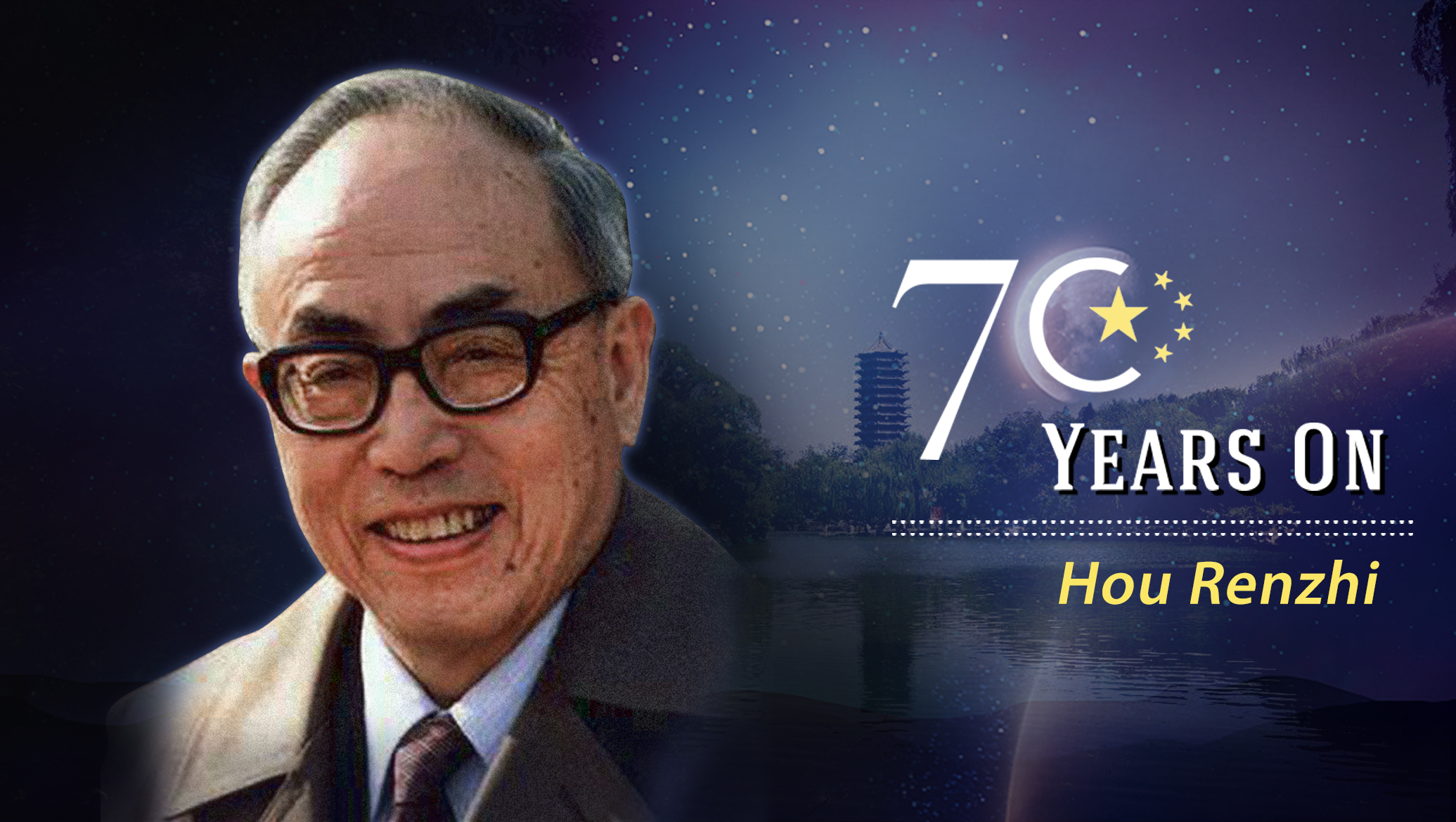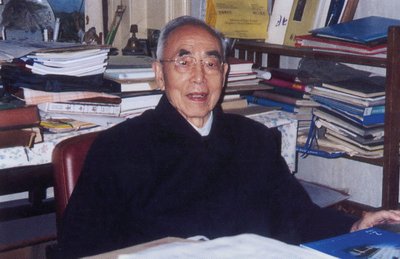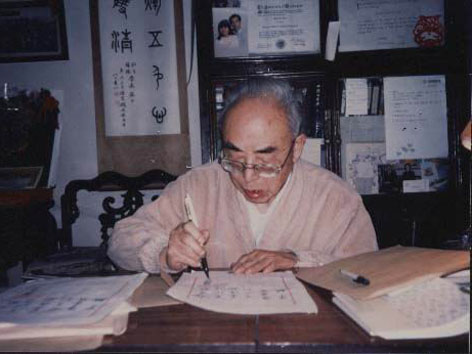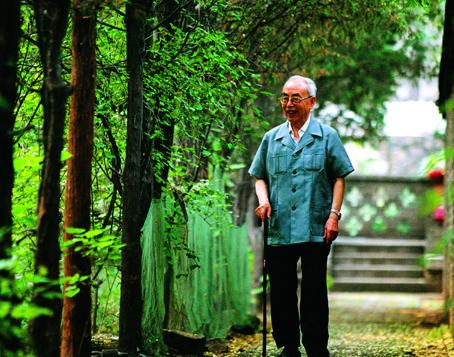[70 years on] Hou Renzhi: A lifelong dedication to academia
Nov 22, 2019
Editor’s Note: This story is part of a series of articles celebrating the 70th anniversary of the founding of the People’s Republic of China. Each article shines the spotlight on one PKUer who has made remarkable contributions to China’s recent development, highlighting not only the importance of their individual accomplishments, but also the significant impact Peking University has had on China’s development over the past 70 years.
Peking University, Nov. 22, 2019: Hou Renzhi is a member of the Chinese Academy of Sciences and a professor of geography at Peking University. He is also the key figure promoting cultural heritage protection in China, as well as the founder of the field of Chinese historical geography. Hou Renzhi dedicated his life to the search for truth through scientific inquiry, a search that extended beyond the walls of Peking University to the outskirts of Beijing, the most rural parts of China, and cities all over the world.
 Hou Renzhi
Hou Renzhi
Hou’s early life
Hou Renzhi was born in 1911 in Zaoqiang county, Hebei province.
At the time of “September 18 Incident” in 1931, which kicked off Japan’s invasion of China during World War II, Hou Renzhi was studying at Luhe Middle School in Tongzhou. In 1932 he enrolled at Beijing’s (then Peiping’s) Yenching University to study for a degree in history and, following his graduation in 1937, was hired as a research assistant for Gu Yugang, the head of Yenching’s Department of History. Under the guidance of Gu, Hou Renzhi learned standards of academic discipline that would play a critical role in his life-long journey on the road of historical research. More importantly, he cultivated a spiritual strength and ambition which would enable him to overcome all obstacles that he encountered along the way.
Following China’s victory in the Anti-Japanese War in 1946, Yenching University sent Hou Renzhi to pursue his Ph.D. at the University of Liverpool under the guidance of Percy Maude Roxby, the head of the university’s Department of Geography. Following Roxby’s untimely death, H.C Darby, the head of the Department of Geography of Cambridge University, became Hou Renzhi’s mentor. Darby’s research method and theory of historical geography made a particularly important impression on Hou Renzhi, introducing him to a whole new perspective on historical inquiry that he would carry back with him to China.
On September 29, 1949, following the completion of his Ph.D., Hou Renzhi returned to Beijing under the arrangement of the Xinhua News Agency in Hong Kong, where he began his efforts to establish the field of historical geography in China.
Hou Renzhi's interest in Chinese historical geography came not only from the teachings of Darby, but also from his life experiences in Beijing. On weekends, he would often walk around the surroundings of Peking University as a way to clear his mind in preparation for his courses. On one of his walks, Hou Renzhi walked to the west side of Yuquan Mountain and saw a stone chasm with a chiseled wall, noticing similarities with other chasms located at the Biyun Temple and the Reclining Budga Temple in Xishan. He imagined that, in the past, these chasms might have served as a passage for water to flow through. After further investigation, he discovered that the water from the Yuquan Mountain chasm had flowed to Kunming Lake, located at the Summer Palace, and flowed down to Beijing. This discovery early on in his academic career became the foundation of his later study of Beijing's historical geography.
During the "Cultural Revolution" period, Hou Renzhi was deported to Liyuzhou, Poyang Lake in Jiangxi province. Following China’s resumption of academic research in some disciplines, such as cultural relics and archaeology, in 1972, Hou Renzhi was allowed to return to his academic endeavors. After the 1978 Science Conference, he returned to the Northwest Sands for an inspection. In 1980, he was elected a member of the Chinese Academy of Sciences, one of the penultimate achievements for a social scientist in China.
Building the discipline of Chinese Historical Geography
Hou Renzhi’s disciple, the deputy secretary-general of the Beijing Geography Society, Zhu Zuxi once summarized Hou Renzhi’s contribution to Chinese geography in four points: developing Chinese “historical geography” into an influential modern discipline; promoting the study of Beijing’s urban historical geography; setting up a comparative study on the planning and construction of capitals in different social systems; and taking the lead in the protection and declaration of China's World Heritage.
The year of 1946 was the turning point of Hou Renzhi's academic career. After receiving his Ph.D. in 1949 and returning to Yenching University, he had already made several breakthroughs in his academic thinking, overcoming the limits of traditional geography and beginning to flesh out the basic tenets of what would become modern Chinese historical geography. In 1950, Hou Renzhi published "The Discussion of China's History Geography Course," which served as the preeminent work on China’s theoretical understanding of historical geography.
Research in China’s remote deserts
Hou Renzhi showcased great enthusiasm and ingenuity when it came to applying his theories of historical geography for the purpose of practical research. The most prominent example is his geographic research of China’s desert environments. Since 1960, Hou Renzhi regularly went to the semi-arid areas of northwest China’s Ningxia province to investigate the desertification and soil erosion in its Yanchi and Lingwu areas.
These desert excursions always proved difficult, if not dangerous. Hou Renzhi recalled them as an important turning point in his academic career, where he “finally walked out of his comfortable office and began to enter the harsh climate of China’s desert." On one particularly notable trip, Hou Renzhi discovered evidence of a large amount of human activities and was surprised by the changes they left on the natural environment. Upon his return from the desert, he published a special research paper, "Exploring the Changes of Hedong Sha District from the Remains of Human Activities.”
At the end of 1962, Hou Renzhi, under the direct leadership of the Agriculture and Forestry Office of the State Council, formulated an ambitious 10-year study plan: from 1963 to 1972, he would complete a comprehensive desert inspection from the west of Inner Mongolia through the Hexi Corridor to the southern part of Xinjiang. Notable parts of this project include a 1963 trip to Ulan Boh to conduct research on the construction of Baotou Steel, and a 1964 trip to the southeast section of the Mu Us Desert in the Ordos to inspect the ruins of two ancient cities on the banks of the Hongliu River.
Protecting Culture and Natural Heritage in China
In the 1980s, Hou Renzhi made another of his great contributions to Chinese academia: helping to facilitate China’s entrance into the World Heritage Convention. This story begins in the spring of 1980, when Hou Renzhi accepted an invitation to give a series of lectures at several schools in the United States and Canada. On one trip to give a lecture at the University of Pittsburgh, he brought with him two Chinese bricks which he would showcase in his lecture. The experience of traveling with such precious objects made Hou Renzhi realize that China needed a mechanism to protect similar historical relics. During his visit to the United States, Hou Renzhi also heard for the first time that there was a Convention on the Protection of the World Cultural and Natural Heritage which could help China fulfill this need. Although the Convention had started more than 10 years ago, few people in China knew of its existence.
After returning to China, Hou Renzhi immediately drafted a proposal as a member of the National Committee of the Chinese People's Political Consultative Conference, writing that "China should participate in the "Convention on the Protection of the World Cultural and Natural Heritage" as soon as possible. Soon after, China became incorporated into the World Heritage Convention.
Hou Renzhi and Beijing
"I have a special affection for the walls and gates of this ancient city. It inspired my historical interest and introduced me to a magnificent science hall." For Hou Renzhi, Beijing not only served as his second hometown for much of his life, but also one of the most important subjects of his research. Along with exploring the theories of historical geography and helping China join the World Heritage Convention, Hou also dedicated his life to investigating the history of Beijing, and made a number of contributions.
First, Hou Renzhi decided to apply his methods of historical geography to uncover the mystery of Beijing’s construction. This was the topic of Hou Renzhou’s 1949 doctoral thesis, "Historical Geography of Beijing." In the view of Wang Nan, an architectural professor at Tsinghua University, Hou Renzhi’s most important contribution to the study of Beijing was to sort out the pattern of Beijing’s urban development. “Hou has determined the location of Beijing in various historical periods through pieces of evidence such as water systems, geography, and archaeological literature. Beijing was the first city of the Zhou Dynasty, but there rarely are scientists who know its specific location. But Mr. Hou read "Shui Jing Zhu" and other studies of the geographical changes of the rivers and lakes, and finally concluded that the city is located in the Guang'anmen area. This is praised as a very large and magnificent contribution."
Second, Hou Renzhi paid great attention to the protection of the historical sites of Beijing. For example, Hou Renzhi publicly called for the protection of the Lugou Bridge, which later led the government to carry out renovations. Since then, Lugou Bridge has not only been renovated several times but also listed as one of the top 10 historical and cultural reservations and was placed on the reservation list for the declaration of World Heritage in the "Beijing Historical and Cultural City Protection Plan." Moreover, in 1998, Hou Renzhi made an important suggestion, to restore the landscape of the Wanning Bridge, an old structure on the central axis of Beijing, which is the starting point for the urban planning of Yuandadu. Hou Renzhi suggested that the water in Shichahai should be led through the back door bridge to restore the landscape under the bridge. It was this suggestion that led to the revitalization of the central axis.
Hou Renzhi s strong passion for Bejing and his great contributions to its restoration has left him with several reputations among the Chinese people. Chief among them are nicknames such as “the life of Beijing,” or “the giant of Beijing history.”
In the winter of 1999, Beijing experienced a meteor shower. Several Peking University students went to the lake to watch it, and found Hou Renzhi sitting at the edge of the lake. He explained to the students the scientific and geographic important of meteor showers, making an already majestic night even more fantastic for the students. This small anecdote is a reflection of Hou Renzhou’s life, highlighting his precious personal characteristics and love for science, academia, and life-long learning.
Hou Renzhi has lived on campus since joining Peking University, but now it is impossible to see him when visiting his residence at Yannan Garden. On October 22, 2013, Hou Renzhi passed away at the age of 102.
Written by: Fang Jiangchen
Edited by: Ethan Paul




